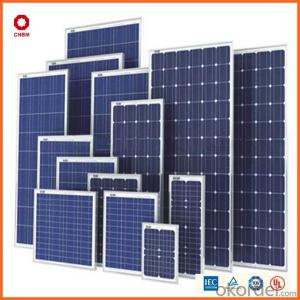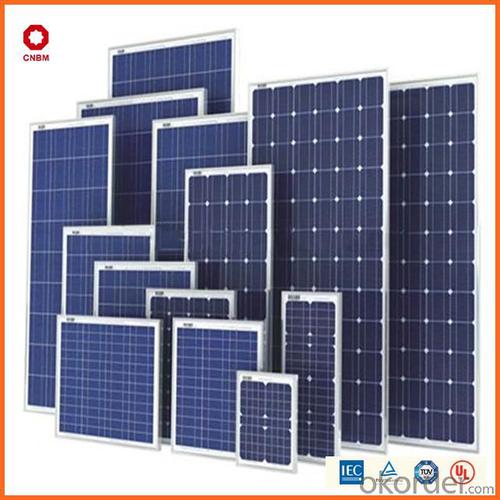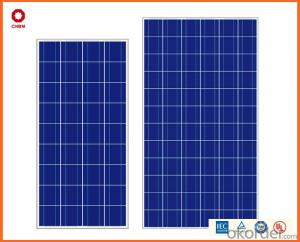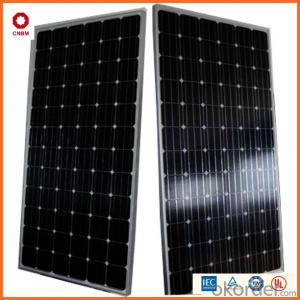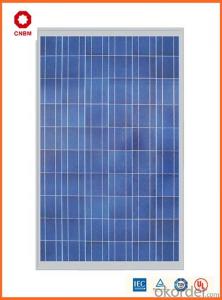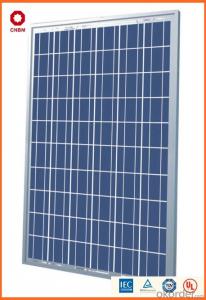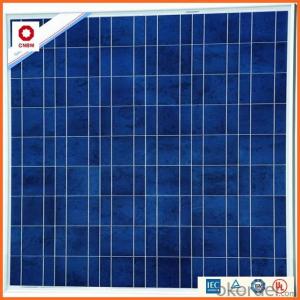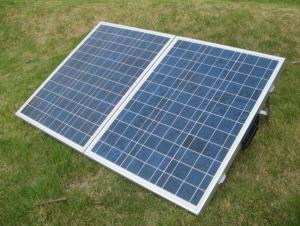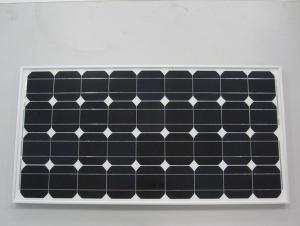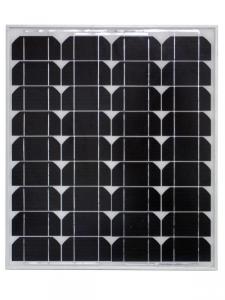7KW Monocrystalline Silicon Solar Panels with CE/IEC/TUV/ISO Approval Standard Solar
- Loading Port:
- China main port
- Payment Terms:
- TT OR LC
- Min Order Qty:
- 100 watt
- Supply Capability:
- 1000000 watt/month
OKorder Service Pledge
OKorder Financial Service
You Might Also Like
Specification
Solar 75W Monocrystalline Silicon Solar Module With CE/IEC/TUV/ISO Approval Standard Solar
CNBM International Corporation is a professional solar panel manufacturer in China for CNBM brand . Silicon panel ( silicon module), as our main product, has high quality and good service. Our products are very popular in Europe, Australia, England, Middle East, Mexico, Argentina, Chili, Singapore and Africa.
Furthermore, our products have gained international authorized certificates like TUV, UL and CE.
China National Building Material (Group) Corporation (CNBM), established in 1984, is one of the largest State-owned group corporations of building & mechanical materials which specializes in the design, manufacturing and distribution of building materials in the world.
As the whole world turns “green”, CNBM enters into the Photovoltaic Industry in 2005.After 6 years' fast growth, now our annual capacity is 500MW solar panel and 500MW solar cell.
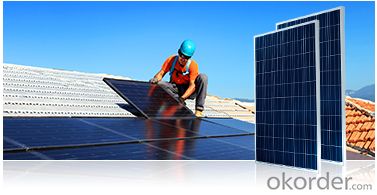
We now provide
• Monocrystalline Solar Panel
• Polycrystalline Solar Panel( multicrystalline silicon Solar Panel)
Features of our products:
Long lifespan: 25Years lifetime guarantee, 12years workshop warranty. 90% output in first 10years. 85% output in next 15years.If module fail during warranty period, please contact local dealer, and provide the warranty card to replace the products.
Solar panels are withstand extreme working condition (from -40°C to 120°C)
Grade A solar panels rated by TUV.
High transformation efficiency solar panels
New UV reflector protected Layer
Maintenance free solar panels
No exposed metal parts
Custom-made available
100% EL TEST before and after laminator for each solar panels
TUV,MCS,CEC,IEC61215,IEC61730,CE,UL approved solar panels
CHUBB insurance company to guarantee the quality of solar panels
Bankable solar panels in German,Italy,UK,Denmark country
As a professional Solar Panel manufacturer and Supplier in China, we have our customers come around the whole world and our specialization has got a worldwide recognition. Meanwhile, with our superior quality, competitive price, prompt and excellent service, As main role in trade section of CNBM Group, CNBM International Corporation supplies products including Monocrystalline Solar Panel, Polycrystalline Solar Panel ( multicrystalline silicon Solar Panel) have received and enjoyed famous reputation in many countries and regions in the world.
- Q: Can solar panels be installed on a house with a flat roof?
- Yes, solar panels can be installed on a house with a flat roof.
- Q: what is a solar panel?
- The term solar panel is best applied to a flat solar thermal collector, such as a solar hot water or air panel used to heat water, air, or otherwise collect solar thermal energy. But 'solar panel' may also refer to a photovoltaic module which is an assembly of solar cells used to generate electricity. In all cases, the panels are typically flat, and are available in various heights and widths. An array is an assembly of solar-thermal panels or photovoltaic (PV) modules; the panels can be connected either in parallel or series depending upon the design objective. Solar panels typically find use in residential, commercial, institutional, and light industrial applications. Solar-thermal panels saw widespread use in Florida and California until the 920's when tank-type water heaters replaced them. A thriving manufacturing business died seemingly overnight. However, solar-thermal panels are still in production, and are common in portions of the world where energy costs, and solar energy availability, are high. Recently there has been a surge toward large scale production of PV modules. In parts of the world with significantly high insolation levels, PV output and their economics are enhanced. PV modules are the primary component of most small-scale solar-electric power generating facilities. Larger facilities, such as solar power plants typically contain an array of reflectors (concentrators), a receiver, and a thermodynamic power cycle, and thus use solar-thermal rather than PV. You could get more information from the link below...
- Q: How do solar panels affect the electricity bill?
- Solar panels can significantly reduce or even eliminate electricity bills by generating clean and renewable energy from the sun. By harnessing solar power, these panels can offset a portion or all of a household's electricity consumption, thereby reducing the amount of power needed from the utility grid. This ultimately leads to lower electricity bills and potential savings over the long term.
- Q: I am completely ignorant on this subject. I was just wondering out of curiosity of how many solar panels and equipment that it would take to run a central ac for a 2500 sq ft home and a pump for a medium sized pool. I'm talking running ac for like 8 hours a day to keep around 65-70 degrees and running the pump 24/7. Just looking for a general ballpark answer.
- Solar panels are not going to be able to run a pool pump 24/7. They will only produce their rated electricity for 4 to 8 hours a day. For the balance you will need a grid connection or a battery backup. Running the AC would require different power levels depending upon humidity, outside temperature levels, solar gain for the house, and insulation levels. An underground house in Maine will be much easier to AC than a Glass house in Arizona. First find the power requirements. If you had the existing equipment they will have a label with the power requirements or the minimum breaker required if nothing else. For example the pool pump may require a 0 amp 240 breaker while the AC may require a 30 amp 240 breaker. That would be 2400 watts for the pump and (30 x 240) 7200 watts for the AC or a total of 9.6kW each hour of operation. (max) You will next need to find the rated capacity of the solar panels. If each panel were rated at 300 watts then you would need 32 panels for the daytime use and perhaps more to fill in a battery backup. All the numbers are very rough estimates.
- Q: Can solar panels be used for powering Wi-Fi networks?
- Yes, solar panels can be used to power Wi-Fi networks. Solar panels generate electricity from sunlight, which can be stored in batteries or directly used to power Wi-Fi routers and other network equipment. This allows for the creation of off-grid Wi-Fi networks in remote areas or during power outages, providing reliable and sustainable connectivity.
- Q: Can solar panels be installed on a carport structure?
- Yes, solar panels can be installed on a carport structure. In fact, carports are a popular choice for solar panel installations because they provide a dual purpose of providing shade for vehicles while generating clean, renewable energy. The structure of a carport offers ample space for solar panels to be mounted, allowing for efficient energy production while maximizing the use of available space.
- Q: I want to get a solar panel to run a fan (or two) for swamp coolers.I'm not looking to power 20box fans, just maybe some of those auto fans.What the heck kind of panel do I need? What is a power inverter and what does it do?Will I lose all my power if I use a 00' extension cord?How do I choose what I'm going to need?
- Solar panels turn sunlight into direct current electricity usually at 2, 24, or 36v. You could probably have a very simple system with just a panel and a few dc fans assuming that: the panels never put out more power than the fans can handle, you don't mind the fans slowing and stopping when the sunlight fades. If you want the fans running more of the time, you will need the panel hooked to a charger that charges a car/marine type battery and the fans connected to the battery. The longer the wires, the thicker they need to be (and more expensive). If you want to use AC (alternating current like your house uses) you will need an inverter (which turns DC into AC). Each device and each section of wire loses power due to inefficiency (heat produced). Contact a solar company on line, in person, or learn more.
- Q: can you buy single solar panels say to power a washing machine fridge etc.if so where can i buy them from
- Solar electricity for single appliances high power is not easily available. By the time you fit the solar panel and all the technology to convert the power into the correct voltage and current, you may as well fit one which will provide for all electricity needs. I have a solar panel charger which can be used to provide power for direct current operated devices and they are a useful backup if your phone or iPod runs out of battery power whilst on the move. The UK energy saving trust has some great advice on how to reduce fuel costs and going green generally, but their major message is conserving energy, using less, is the best thing that you can do for the planet.
- Q: I bought a pack of OEM mini solar panels that produce 4.2v and 22mA and I was just wondering how many LED's I could hook up to one mini solar panel? I currently have one green LED with a resistor on the one panel but was wondering how many I could possibly run off of one panel?
- Typically LED's run off low voltage and 20mA or so of power (it depends what kind of led you have). That being said if one of your solar panels only provides 22mA of power then your circuit would have to be a series circuit for you to connect more than one. In a series circuit the current supplied of 22mA will go through each LED whereas a parallel circuit the current would be divided for each subsequential led. So in your case i can see you getting away with 3 or so led's before the voltage drop across each led will cause the voltage to be insufficient enough to drive anymore. Keep in mind the LED's will turn on but the first one will be bright then next one not as bright and so on. If you opted out and bought a solar panel with 200mA and 4V you could wire the led's in parallel and get 0 led's to turn on with the same brightness or intensity. Hoped that helped!
- Q: I am looking to run 2 basic shoplights, each with 2- 32 watt T8 flourecent tubes for 6 hours a day for an indoor garden. Location WI.
- Lets say, for a simple approximation, that the 45 watt panel produces 45 watts /3 of the time and nothing the rest of the time. Each day, this will produce 8 hours times 45 watts = 360 watt hours. Also assume the battery charge controller and inverter waste half of that power, leaving 80 watt hours per day. If you use compact fluorescent lamps, that would allow you to burn 80 watts worth for an hour every day, or 90 watts for 2 hours, etc. That is a lot of light for a shed. You might consider using much less efficient tungsten filament lamps, but eliminate the inverter and choose low voltage (automotive) lamps that can run directly across the battery and lower the total cost, but give you only about half the light times time. The main advantage of the inverter might be that it would allow you to use small power tools or appliances in the shed. -- Regards, John Popelish
Send your message to us
7KW Monocrystalline Silicon Solar Panels with CE/IEC/TUV/ISO Approval Standard Solar
- Loading Port:
- China main port
- Payment Terms:
- TT OR LC
- Min Order Qty:
- 100 watt
- Supply Capability:
- 1000000 watt/month
OKorder Service Pledge
OKorder Financial Service
Similar products
Hot products
Hot Searches
Related keywords
